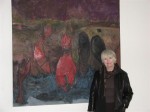“In the Catskills” with George Inness
In the coming months I will research intriguing art from area museums, and I’ll spin a tale about why I like the chosen. This takes up where Tom Strini left off with his superb summer series of just-right moments in art at the Milwaukee Art Museum.
George Inness: Painting school at Charles Allis
Come in. Step out of the marbled hall and into the library that once belonged to the very wealthy Mr. and Mrs. Charles Allis. I like it that this intimate space speaks in undertones and who would guess that on the other side of the windows facing Prospect Avenue, traffic whips by at warp speed while a photographer captures wedding moments near the English Garden.
Today, there is nary a chair in the library. Even the ghost of Charles Allis needs sit down once in a while.
In front of me, third painting from the left and hung at eye level on the west wall, is a work (In The Catskills) I have long admired, and my devotion hasn’t dimmed one whit. If I squint or stand back far enough, the image could be a green space in Kettle Moraine or an Iowa glade yearning to be entered.
But this is a scene from somewhere in the Hudson River Valley, in the state of New York, where George Inness was born the fifth child of thirteen. His dad wanted him to be a grocer.
Lucky for me, the fifth born chose another path: instead of selling greens, he eventually used varying shades of green oil paint to shape and tone his landscapes on canvas and board. This one is not over-the-top-heroic in the sense of say, a wildly romantic painting by Thomas Cole (over there on the east wall), or some of Inness’ obviously overblown imaginings. Almost anyone viewing this particular work may say, “Hey, I’ve been in that very spot,” even though possibly they haven’t.
What I see here is a grassy green glade for Everyman. Painted in approximately 1880, it is in the vein of his later work and was purchased in 1909 from the Noe Art Galleries on Fifth Avenue in New York City. Since the purchase, it has been placed under a sheet of glass — a practical touch but one that detracts.
The foreground welcomes me in, and on to the woods in the middle ground leading to a gentle rise far beyond. Hidden somewhere, is there a path for hiking? I’d like to think so, as the Catskill area is currently a backpacking hot spot.
The sky is blue brushed with friendly clouds, unlike the clouds of roiling thunderstorms the painter so loved to portray. Anyone who lives near Lake Michigan knows the dramatic power of a monster storm, the hopeful surprise of an elegant sunrise and, later, the orangey west-horizon farewell of that same orb, but frankly, it’s the lack of drama in this work that draws me nearer.
The world outside is drama enough. I seek serenity.
Inness was also epileptic and I’m thinking his “storm” paintings were somehow linked with the approaching storms in his brain. He was reputed to be frail, but any artist who produces thousands of works surely had a grip on life. Most of his landscapes were cobbled together in his head. He was not a plein-air kind of guy who liked wearing a yellow oilskin slicker while braving the elements.
It’s said that his images are loaded with religious symbolism, and indeed, this seems to be so if one is to believe the online sampling of his work. Often, heavily wooded areas part to reveal arched openings to blue skies beyond (promising heavenly rewards?), and I’m safe in saying his thunder-boomers referenced safe passage under the watchful eye of his mystical God.
We need remember that Inness (1825-1898) was primarily self-taught and that he honed his craft in the days when getting cozy with Nature was in vogue.
A wanderer at heart (as a teenager he worked as a map maker), he didn’t pin himself to the Hudson River Valley. Instead he traveled extensively, lived in an Italy steeped in religious beliefs, and when he died he was laid to rest in Scotland. His son (another George) claims his father was viewing a sunset there when he “threw up his hands and exclaimed, ‘Oh God, it’s so beautiful.’” He promptly (and dramatically) dropped dead.
Ms. Moriarty is the former editor/publisher of Art Muscle magazine. A Milwaukee painter and writer, she graduated in the heady 70s (from Carroll College) with a degree in Art Education.
Art
-
It’s Not Just About the Holidays
 Dec 3rd, 2024 by Annie Raab
Dec 3rd, 2024 by Annie Raab
-
After The Election Is Over
 Nov 6th, 2024 by Annie Raab
Nov 6th, 2024 by Annie Raab
-
The Spirit of Milwaukee
 Aug 30th, 2024 by Annie Raab
Aug 30th, 2024 by Annie Raab






















This is beautiful, Judith Ann. Thanks. — Strini